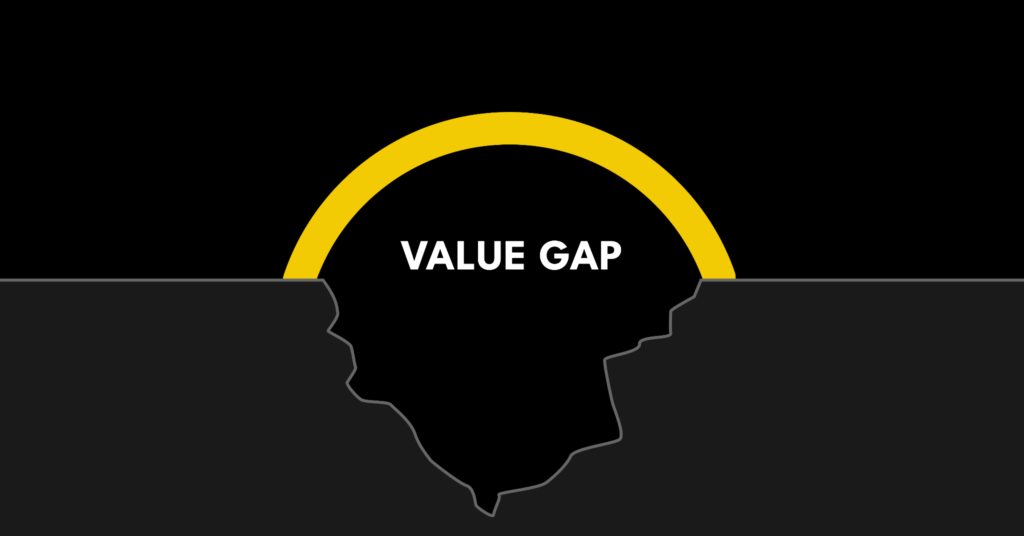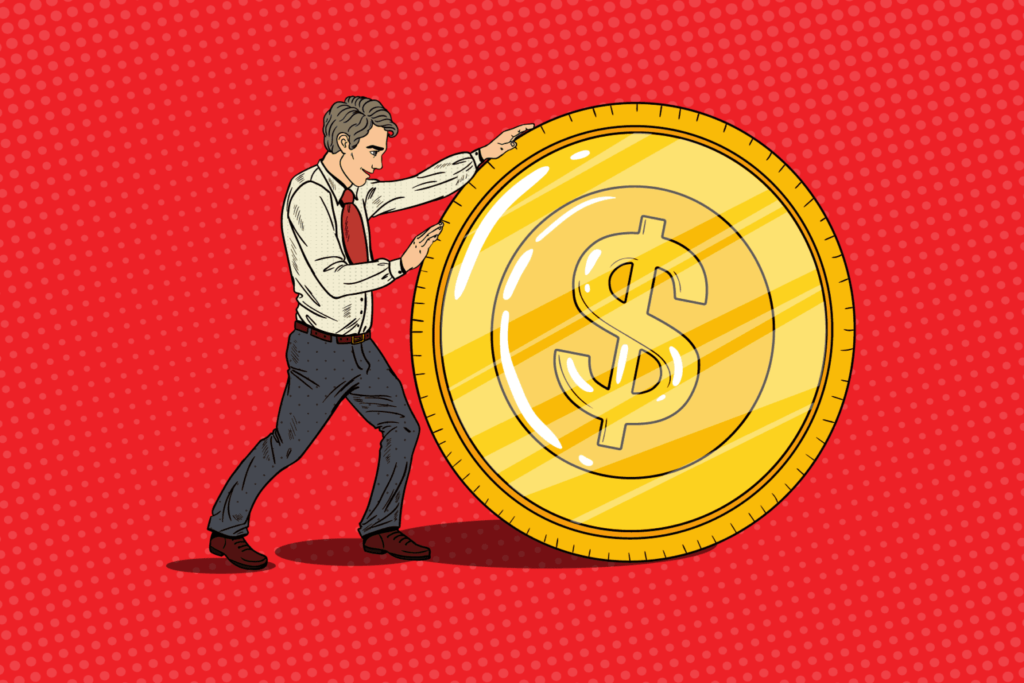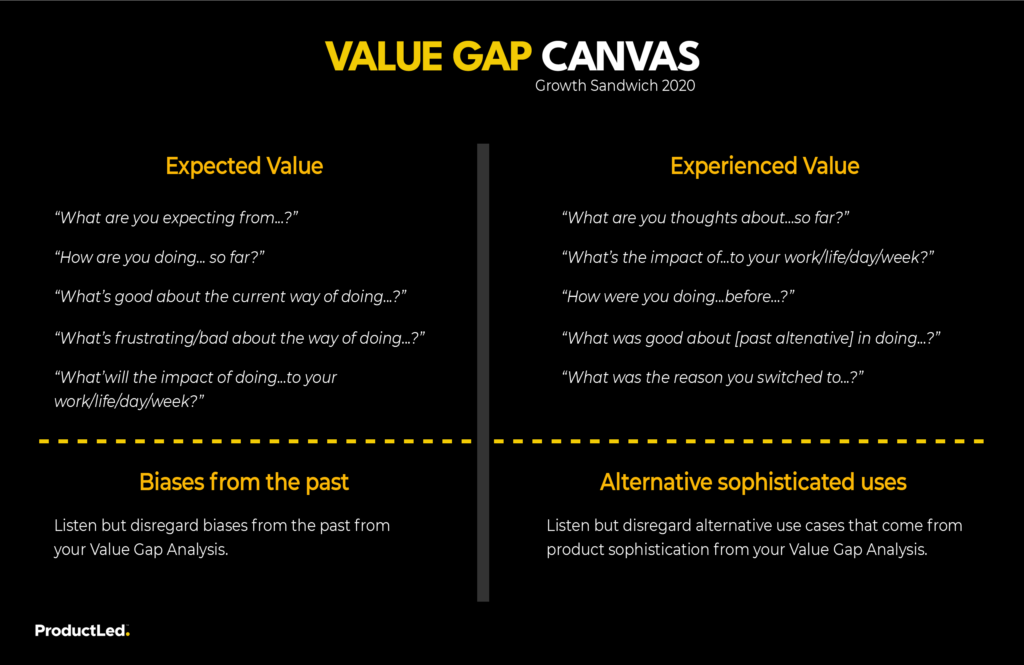In the fast-paced world of technology, Software as a Service (SaaS) has emerged as a leading business model that allows businesses to leverage software solutions over the internet on a subscription basis. This model presents numerous advantages, including lower upfront costs, scalability, and access to the latest features.
Yet, despite these benefits, SaaS companies often grapple with an issue that threatens customer retention and overall success: the Value Gap. This gap, the difference between a product or service’s perceived and actual value, can significantly impact customer satisfaction and loyalty.
This comprehensive guide will delve deep into the concept of the Value Gap, its significance in the SaaS context, strategies for identifying it, and effective methods to bridge this gap and enhance your value proposition.
Understand the Value Gap
What is the Value Gap?
At its core, the Value Gap is the discrepancy between what customers expect from a product or service and what they receive. If a customer perceives the value of a product to be high based on marketing promises or personal expectations but then feels short-changed upon using the product, a Value Gap exists.

In the realm of SaaS, the Value Gap can manifest when there’s a disconnect between the promised benefits of a software solution (such as ease of use, increased productivity, and cost savings) and the user’s experience. This gap can breed dissatisfaction and mistrust, leading to customer churn and a potential decrease in revenue.
Why Does the Value Gap Occur?
The emergence of the Value Gap can be attributed to various factors. Often, it stems from a misalignment between a company’s understanding of customer needs and the actual customer expectations. This misalignment can result from poor communication, a lack of customer understanding, or a failure to deliver on promises.
For instance, a SaaS company might believe its software’s complex features are of high value. However, if customers find these features confusing and non-intuitive, they may perceive low value in the product, leading to a Value Gap.
Importance of the Value Gap in SaaS
Customer retention is paramount in the SaaS industry, where businesses operate on subscription models. Acquiring a new customer is often more expensive than retaining an existing one. Therefore, a significant Value Gap that leads to high customer churn rates can negatively impact a company’s bottom line.
Moreover, the rise of customer-centric business models has placed customer perception at the forefront. Today, the customer’s perceived value of a product or service is a key determinant of market success. Therefore, SaaS companies that successfully manage and bridge their Value Gap can gain a competitive edge.
Also, closing the Value Gap is not just about retaining customers; it’s about turning them into advocates for your brand. Customers who perceive high value in your product will not only continue using it but are also likely to recommend it to others, thus driving organic growth for your business.
Identifying the Value Gap
Before closing the Value Gap, it’s crucial to identify its presence and understand its breadth and depth. Here are some methods to help you do this:

Customer Surveys
Customer surveys are a powerful tool to gauge what customers value in your product or service and where they feel the offering falls short. Regularly conducting surveys can provide valuable insights into your customers’ minds and help you identify potential Value Gaps.
You could ask questions about their expectations, experience with your product, and perception of its value. Be sure to include open-ended questions that allow customers to express their thoughts freely.
User Behavior Analysis
Analyzing user behavior within your software can offer rich insights into potential Value Gaps. By observing how users interact with your product, you can identify areas where users struggle or abandon the product.
For instance, if users frequently drop off at a particular feature or rarely use it, it could indicate that this feature is not delivering the expected value. Similarly, frequent requests for support or complaints about specific aspects of your software can also signal a Value Gap.
Customer Interviews
Customer interviews offer an opportunity to delve deeper into customer expectations and experiences. By engaging customers in direct conversations, you can better understand their needs, expectations, and perceptions.
These conversations can uncover hidden issues that might not surface through surveys or user behavior analysis. They can also help you understand why customers perceive a value gap, allowing you to address the root cause rather than just the symptoms.
Strategies to Close the Value Gap
Once you’ve identified the Value Gap, the next step is to devise strategies to close it. Here are some effective strategies:

Improve Product Quality
Improving the quality of your product is one of the most straightforward ways to close the Value Gap. This could involve enhancing existing features to make them more user-friendly, fixing bugs that disrupt the user experience, or introducing new features that add value to the user.
Remember, your customers’ needs and feedback should guide any improvements. There’s no point in introducing a fancy new feature if it doesn’t align with your customer’s values.
Enhance Customer Service
Exceptional customer service can significantly enhance the perceived value of your product. This can involve improving response times to customer queries, providing more personalized service, or offering better after-sales support.
Consider offering multiple support channels (email, chat, phone) and ensuring your support team is well-trained and empathetic. Remember, every interaction with your customer is an opportunity to deliver value.
Communicate Effectively
Clear and consistent communication with customers can help manage their expectations and prevent the formation of a Value Gap. This includes marketing communication, onboarding, support, and regular updates.
Ensure your marketing promises align with what your product delivers. During onboarding, help customers understand how to extract maximum value from your product. Regularly update customers about new features, improvements, and how they add value to their experience.
Case Study: Successful Value Gap Closure
Adobe, a giant in the world of software, provides a compelling example of successful Value Gap closure. The company transitioned from selling packaged software to a cloud-based subscription model with Adobe Creative Cloud. Initially, there was a significant Value Gap as customers grappled with the new model and felt the subscription cost did not deliver equivalent value.
However, Adobe managed to bridge this gap by enhancing its product offering with regular feature updates, improving its customer service, and communicating effectively with its customers about the benefits of the new model. Today, Adobe Creative Cloud successfully demonstrates the power of effectively managing the Value Gap.
FAQs
What is the Value Gap in SaaS?
The Value Gap in SaaS refers to the discrepancy between the value a customer expects from a software service and the actual value they receive. It occurs when the perceived benefits of a software solution do not align with the user’s experience, resulting in dissatisfaction and potential customer churn.
What causes a Value Gap in SaaS?
A Value Gap typically arises from a misalignment between a company’s understanding of customer needs and the actual expectations of the customers. This could result from poor communication, lack of customer understanding, or failure to deliver on promises. A Value Gap may occur if a company believes its complex software features are valuable but customers find them confusing or non-intuitive.
Why is the Value Gap significant in the SaaS industry?
Customer retention is crucial in the SaaS industry, where businesses operate on subscription models. A significant Value Gap can lead to high customer churn rates, negatively impacting a company’s bottom line. Moreover, in today’s customer-centric business models, the perceived value of a product or service is a key determinant of its market success. Therefore, effectively managing and bridging the Value Gap can offer a competitive advantage.
How can SaaS companies identify the Value Gap?
SaaS companies can identify the Value Gap through customer surveys, user behavior analysis, and customer interviews. Regularly conducting surveys can provide insights into what customers value and where they feel the offering falls short. Analyzing user behavior can help identify areas where users struggle or abandon the product, indicating a potential Value Gap. Direct customer conversations can also provide deeper insights into their needs, expectations, and perceptions.
What are some strategies to close the Value Gap in SaaS?
Closing the Value Gap involves improving product quality, enhancing customer service, and communicating effectively. Product improvements could include enhancing existing features or introducing new ones based on customer feedback. Exceptional customer service can enhance the perceived value of the product. Clear and consistent communication helps manage customer expectations and align them with the product experience.
Conclusion
The value gap represents a significant challenge for SaaS companies and a remarkable opportunity. By understanding what it is, why it’s important, and how to identify it, companies can develop effective strategies to close the Value Gap.
Improving product quality, enhancing customer service, and communicating effectively are all strategies that can help bridge the Value Gap. These efforts can reduce customer churn, increase customer satisfaction, and drive business growth.
Ultimately, the goal is to ensure that the value customers receive meets — or, better yet, exceeds — their expectations. This alignment between expectation and reality will lead to increased customer loyalty and turn customers into advocates for your brand. In the competitive landscape of SaaS, closing the Value Gap can be the key to standing out and achieving sustainable success.
Start Your Journey with OnBoardSaaS Today!
Are you ready to transform your SaaS business and bridge that Value Gap? Don’t let customer churn and dissatisfaction hinder your growth.
At OnBoardSaaS, we specialize in helping SaaS companies like yours identify and close the Value Gap effectively. Our comprehensive solutions guide you through understanding your customers’ needs, enhancing your product quality, improving customer service, and communicating effectively to align customer expectations with reality.
Don’t wait for the gap to widen. Start your journey towards a more customer-centric and successful SaaS business today!
Let’s close the Value Gap and drive your SaaS success to new heights!

10+ years experience in Marketing and Operations

